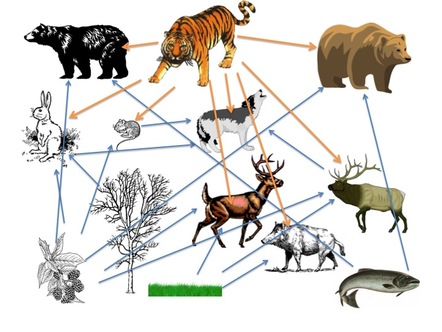Tigers are one of the most majestic animals on our planet.For centuries, the tiger has been revered for its magnificence, power, beauty, and fierceness. It is also a symbol of bravery and valor. In Hindu mythology, the tiger holds great significance as the vehicle of Goddess Durga. However, the importance of tigers extends beyond cultural and religious beliefs. They are essential to the health of our planet’s ecosystems and play a crucial role in preserving biodiversity. This blog will delve into the reasons why tigers are crucial for our ecosystem and examine the factors behind their decline in India.

Why are Tigers Important for Our Ecosystem?
Tigers are apex predators, meaning they are at the top of the food chain. As such, they play a vital role in maintaining the delicate balance of the ecosystem. Without tigers, the populations of their prey, such as deer and wild boar, would grow unchecked, leading to overgrazing and other negative impacts on the environment. In turn, this could lead to the extinction of other species and the collapse of entire ecosystems.
In addition to regulating the populations of their prey, tigers also help to maintain the health of the forests they live in. Tigers are known as keystone species, meaning they have a disproportionately large impact on the ecosystem compared to their numbers. By hunting and killing weaker or diseased prey, tigers help to keep the population healthy and prevent the spread of disease. Furthermore, tigers help to shape the physical environment of the forest by creating trails and clearings that allow sunlight to reach the forest floor, which is critical for the growth of vegetation.
Tigers are also important for maintaining genetic diversity. As top predators, tigers can move long distances in search of food and mates, which helps prevent inbreeding and maintain healthy genetic diversity in their populations. This genetic diversity is critical for the long-term survival of the species and for maintaining the health of the ecosystem.

Tiger Population in India
India is home to more than 70% of the world’s tigers, and the country has a long history of conservation efforts aimed at protecting the species. Despite these efforts, the tiger population in India has been declining rapidly over the years.
In recent news, Indian Prime Minister Narendra Modi announced that the number of tigers in India has significantly increased. The latest tiger census data shows that there are now 3167 tigers in India, which is 200 more than in 2018 when the count was 2967. This rise in numbers is a positive development, as tigers are crucial to our ecosystem.
Furthermore, the data showed that the tiger population has doubled in the last two decades in India. In 2006, there were 1411 tigers in India, and this number increased to 1706 by 2010. By 2014, there were 2226 tigers in India, indicating significant growth in India’s tiger population.
Project Tiger has played a vital role in this success story. It is a matter of pride not only for India but also for the world. The country has not only conserved tigers but has also provided them with a conducive ecosystem to thrive. India is the largest tiger range country globally and firmly believes in the co-existence of the economy and ecology. The increased number of tigers in India is a testament to the country’s commitment to saving its wildlife.
However, the population is still far from the estimated 100,000 tigers that existed in India just a century ago.
One of the biggest threats to the tiger population in India is habitat loss. India’s population is growing rapidly, and as a result, there is increasing pressure on the country’s forests for agriculture, mining, and other activities. This has led to the fragmentation of tiger habitats, making it harder for the animals to move between areas and find mates. Furthermore, habitat loss has led to a decline in the prey species that tigers depend on, further exacerbating the problem.
Poaching is another significant threat to the tiger population in India. Tiger parts, such as their bones and skin, are highly valued in traditional medicine and luxury goods. Despite the fact that tiger hunting has been illegal in India since the 1970, poaching continues to be a major problem. Poachers often use traps, snares, and other illegal methods to capture and kill tigers, which can devastate local populations.

What are the Indian and international laws that protect tigers?
The Indian Tiger is an endangered species and is accorded protection under the Wildlife (Protection) Act of 1972, where it is listed under Schedule I. This act prohibits hunting, poaching, and trade of tiger body parts, such as bones, skins, and other body parts. Those found guilty of such offenses face imprisonment of at least three years and a fine of no less than fifty thousand rupees, which may extend to two lakh rupees. Repeat offenders can receive imprisonment for at least seven years and a fine ranging from five lakh rupees to fifty lakh rupees.
The Convention on International Trade in Endangered Species of Wild Fauna and Flora (CITES) is an international agreement signed by over 160 countries that prohibits the international trade of tiger parts. India has been a signatory of this convention since 1975.
Who are the major stakeholders in tiger conservation in India today?
In India, various entities have a vested interest in tiger conservation. The government of India, specifically the Ministry of Environment and Forests, State Forest Departments, and the National Tiger Conservation Authority, are some of the primary stakeholders in tiger conservation. Local communities, tourism departments, media outlets, and NGOs like WWF-India, as well as other organizations and corporations, also play a significant role in supporting tiger conservation efforts.
Conclusion
In conclusion, tigers are an essential part of our planet’s ecosystems, and their decline in India is a cause for concern. The loss of tigers would have far-reaching consequences for the health of the environment and the survival of other species. Fortunately, there is still time to reverse the trend


